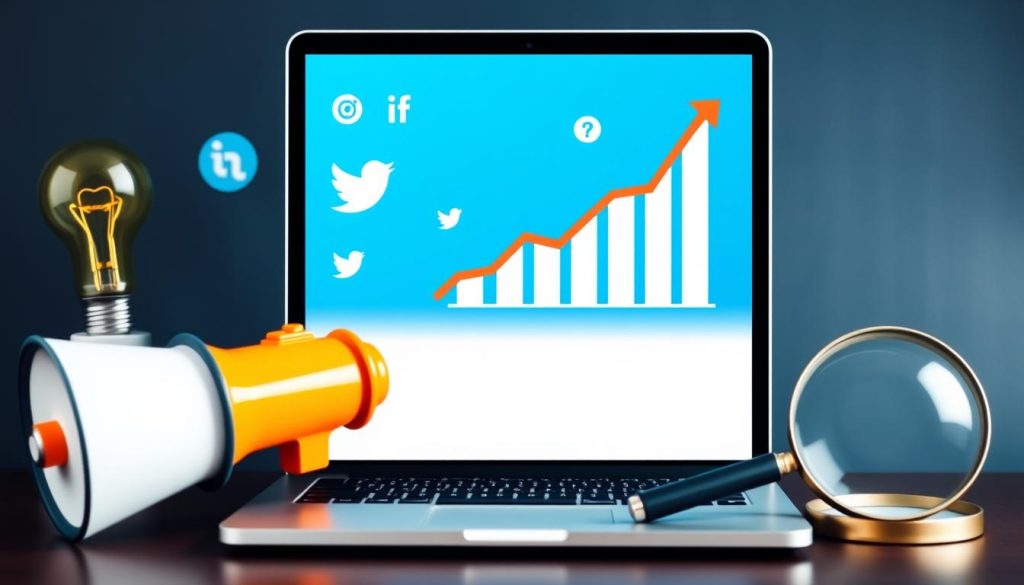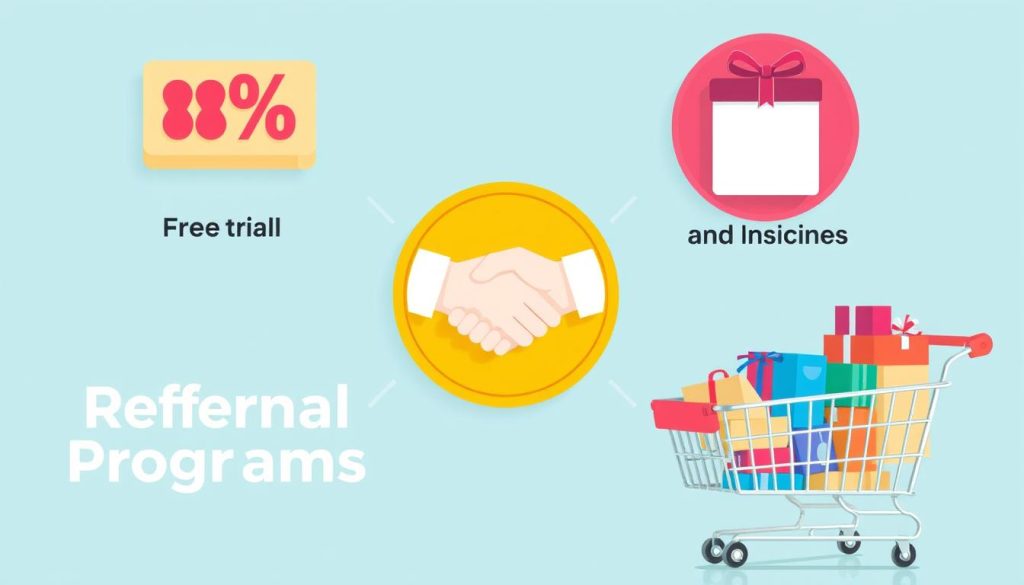Growing a user base for software can be challenging in today’s competitive market. However, with the right strategies, you can promote your software effectively. This guide will help you navigate the challenges of software promotion with a limited user base.
We’ll explore tactics to grow your software’s user base and increase brand awareness. You’ll learn how to drive meaningful interactions with your target audience. We’ll cover strategies from social media to content creation and influencer collaborations.
Key Takeaways
- Identify your target audience and understand their preferences and behaviors
- Leverage social media platforms to build an engaged community around your software
- Create valuable, shareable content that resonates with your audience
- Collaborate with industry influencers to tap into new audiences
- Utilize email marketing campaigns to nurture leads and drive conversions
- Attend industry events and meetups to network and build connections
- Offer incentives and promotions to encourage user engagement and retention
Understanding Your Target Audience
Knowing your target audience is key to promoting your software effectively. Research user demographics like age, location, interests, and pain points. Analyze user behavior to uncover valuable insights about product engagement.
Identifying Key Demographics
Create a detailed profile of your target audience. Consider factors like age range, geographic location, and occupation. Include income level, education background, and hobbies in your research.
These user demographics will help tailor your marketing strategies. You can create content that resonates better with your audience.
Analyzing User Behavior and Preferences
Explore user behavior analysis to understand how people interact with your product. Look at preferred platforms, typical browsing habits, and purchasing patterns. Identify pain points and challenges faced by your audience.
This customer insights will guide your market segmentation efforts. It helps create content that truly connects with your audience.
“Understanding your target audience is the key to effective marketing and promoting your software successfully.” – Jane Doe, Marketing Strategist
| Demographic | Insights | Implications for Marketing |
|---|---|---|
| Age | 25-35 years old | Use more casual, relatable tone; focus on mobile-friendly content |
| Location | Primarily in urban areas | Tailor messaging to address local pain points and preferences |
| Interests | Technology, productivity, entrepreneurship | Create content that aligns with their professional and personal interests |
Leveraging Social Media Platforms
Even a small social media following can boost your social media marketing. Choose platforms that match your target audience. Build an engaged community around your software for best results.
Building an Engaged Community
Create an engaged community by sharing valuable content your audience loves. This can include tutorials, updates, and industry insights. Share behind-the-scenes peeks into your development process too.
Ask questions, run polls, and start discussions to encourage interaction. This builds trust and a sense of belonging. Respond quickly to comments and questions.
- Respond promptly to comments and queries, demonstrating your commitment to your audience.
- Leverage user-generated content, such as testimonials and reviews, to amplify your audience engagement.
- Organize exclusive events or giveaways to reward your most loyal followers and incentivize community growth.
Deliver valuable content consistently to build a loyal following. This helps spread the word about your software. It also establishes your brand as a trusted solution.

“Social media is not just a digital marketing tool, it’s a way to build relationships and foster a sense of community around your brand.”
Content Marketing Strategies
Effective content marketing is vital for promoting software, even with a small following. Create valuable, informative content to position your brand as a trusted authority. This approach can help attract a loyal audience to your software.
Creating Valuable and Shareable Content
Craft content that speaks to your target audience. Address their pain points and share industry insights. Provide practical solutions to their problems.
Use various formats like blog posts, videos, and infographics. This mix caters to different preferences. It also increases the chances of your content being shared.
- Identify topics that your audience finds genuinely helpful and interesting.
- Deliver content that is well-researched, visually appealing, and easy to consume.
- Encourage user-generated content and foster a sense of community around your brand.
Optimizing for Search Engines
Search engine optimization (SEO) is crucial for improving visibility. It drives organic traffic to your website. Conduct keyword research and optimize your content for target keywords.
Implement best practices for on-page SEO. This includes using meta tags, alt text, and internal linking. These tactics help search engines understand and rank your content better.
| SEO Tactic | Description | Benefits |
|---|---|---|
| Keyword Research | Identify the most relevant and high-performing keywords for your software and industry. | Optimizes content for better search engine rankings and lead generation. |
| On-Page Optimization | Implement best practices such as meta tags, alt text, and internal linking to enhance the searchability of your content. | Improves the content distribution and visibility of your software on search engine result pages. |
| Content Syndication | Leverage platforms like social media, email, and guest posting to amplify the reach of your content marketing efforts. | Expands your audience and drives more traffic to your website, ultimately boosting lead generation. |
These content marketing strategies can effectively promote your software. They help engage your target audience and drive results, even with a small following.
Influencer Collaborations
Influencer marketing can revolutionize your software promotion. Industry experts can boost your reach and credibility. Their established followings can drive valuable brand partnerships.
Choose influencers who match your brand values. Look for engaged, relevant audiences. Consider industry bloggers, social media stars, or fellow developers.
Explore various collaboration options:
- Product reviews where the influencer shares their honest thoughts and experiences with your software
- Guest posts on the influencer’s platform to showcase your expertise and introduce your product to their audience
- Social media takeovers where the influencer takes over your brand’s channels for a day, providing unique insights and content
- Joint promotional campaigns that leverage the influencer’s reach and your product’s value proposition
Industry experts’ credibility can effectively promote your software. Their influence can help expand your reach. This strategy can foster meaningful brand partnerships.

| Benefit | Description |
|---|---|
| Credibility | Influencers’ reputations can boost your software’s trustworthiness. Their endorsement can significantly enhance your product’s credibility. |
| Audience Expansion | Access to influencers’ followers opens new doors. You can introduce your software to a targeted, ready-to-engage audience. |
| Brand Partnerships | Successful collaborations can spark long-term relationships. These can lead to exciting co-marketing opportunities. |
How To Promote Software With A Small Following
Utilizing Targeted Advertising
Targeted advertising can boost your software promotion efforts. Use Google Ads, Facebook Ads, or LinkedIn Ads to reach your target audience. Try various ad formats and targeting parameters to drive conversions.
Precise audience segmentation is a key advantage of targeted advertising. Analyze user data to create targeted campaigns that resonate with potential customers. This approach improves ad effectiveness and maximizes your budget.
Retargeting campaigns can bring back users who’ve interacted with your software. Personalized ads keep your brand memorable. They encourage actions like free trial sign-ups or purchases.
Successful paid advertising requires ongoing testing and optimization. Monitor campaign performance and analyze data regularly. Adjust your targeting, messaging, and ad creative for the best results.
“Effective advertising is not about interrupting people, but about engaging them with content that they find genuinely interesting or useful.”
Email Marketing Campaigns
Email marketing is a powerful tool for software promotion. It’s especially effective when you have a small following. The key is building an engaged mailing list through valuable lead magnets and informative newsletters.
Email automation helps nurture leads and keeps your software in mind. It’s a great way to stay connected with your audience.
Building an Engaged Mailing List
Create lead magnets that solve your audience’s problems. Offer e-books, checklists, or exclusive software features. Display these lead magnets on your website and social media to attract sign-ups.
Send regular updates and product info to your subscribers. Use email automation to make this process easier. This builds strong relationships with your audience.
| Email Marketing Strategies | Benefits |
|---|---|
| Lead Magnets | Attract new subscribers by offering valuable resources |
| Automated Newsletters | Keep your audience informed and engaged with your software |
| Personalized Messages | Strengthen customer relationships and foster loyalty |
Email marketing can boost your software’s success, even with a small following. It drives lead generation and customer engagement. With the right approach, your software can reach new heights.

Attending Industry Events and Meetups
Promoting your software can be challenging with a small following. Industry events and local meetups offer great opportunities. They boost brand visibility, networking, and customer acquisition.
These events showcase your product to a wider audience. You can connect with industry influencers and build valuable partnerships. They provide a platform to demonstrate your software’s value.
Networking and Building Connections
At events, focus on networking and building meaningful connections. Engage with potential customers, industry peers, and decision-makers. Participate in discussions, host demos, or consider sponsoring the event.
Successful networking is more than handing out business cards. Have genuine conversations and listen to your audience’s needs. Position your software as a valuable solution to their challenges.
Foster these connections to build long-term relationships. This approach can open doors to customer acquisition opportunities. It helps establish your software as innovative within the industry.
| Event Type | Potential Benefits | Tips for Success |
|---|---|---|
| Industry Conferences |
|
|
| Local Meetups |
|
|
Active participation in industry events and networking can significantly boost your software’s impact. It enhances brand visibility, creates partnership opportunities, and drives customer acquisition.
Offering Incentives and Promotions
Incentives and promotions can boost software marketing efforts. These strategies attract new users and keep current customers happy. Tactics like discounts, free trials, and referral programs can build loyalty and engagement.
Promotional campaigns can draw in new users effectively. Limited-time discounts let potential customers try your software at a lower cost. This appeals to budget-conscious users who want to test your product.
Free trials allow users to explore your software before buying. This removes entry barriers and encourages product engagement. Users can experience your software’s value firsthand, increasing the chances of conversion.
Referral programs are powerful marketing tools. They reward existing customers for recommending your software to others. This taps into word-of-mouth marketing and expands your user base organically.
Well-designed referral programs boost user acquisition and foster community engagement. Customers become invested in your software’s success, creating a loyal user base.

Successful incentives require understanding your target audience’s needs. Tailor your offerings to address their preferences and pain points. This creates a compelling value proposition that sets you apart from competitors.
Measuring and Optimizing Your Efforts
Software promotion needs ongoing performance tracking, data analysis, and marketing optimization. Monitor your efforts to find what works and where to improve. This process helps refine your strategies for better results.
Track key metrics like website traffic, user engagement, and conversion rates. Analyze this data to understand your audience’s behavior and preferences. Use these insights to improve your marketing campaigns over time.
Try A/B testing to compare different approaches. Test various messaging, content formats, and promotional channels. Let the data guide your decisions for better outcomes.
“The only way to do great work is to love what you do. If you haven’t found it yet, keep looking. Don’t settle.” – Steve Jobs
Software promotion is a long-term effort, not a quick fix. Keep measuring, analyzing, and improving your strategies. This approach will help build a strong audience and drive growth for your product.
Conclusion
Promoting software with a small following requires a strategic approach. Focus on understanding your target audience and leveraging social media platforms. Implement content marketing strategies and collaborate with influencers to grow your user base.
Build an engaged community around your software. Create valuable, shareable content that resonates with your audience. Optimize your efforts for search engines to increase visibility.
Measure and refine your strategies continually. With persistence and data-driven decisions, you can overcome promotional challenges. Your product can become a leading solution in your industry.
Apply these strategies to achieve software promotion summary and small following strategies. You’ll be on the path to marketing success and user base growth. Use these key takeaways to boost your software’s visibility and market position.




